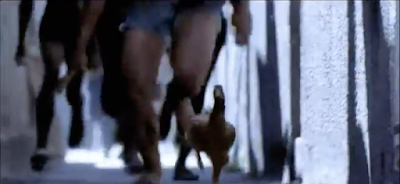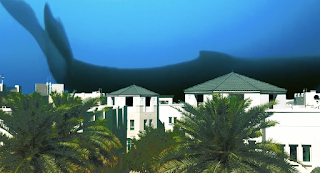Analyzing ''City of God''
Analyzing a 4-minute opening scene from
Fernando Meirelles' City of God (2002)
In the beginning there’s a usage of very fast
jump cuts alongside with close-ups of either the man sharpening his knife in
quick shots fading to black very quickly or close up shots on the chicken, then
when the chicken escapes they tend to use mostly Mid-shots to Extreme
wide shots of the chicken running while the gang is chasing it also you can hear
natural sounds such as the chicken or the gang screaming but also with
some music being attached, the movement of the camera is mostly handheld giving
a more realistic feeling, for the lighting it would be of low contrast with
natural light with a light tone of blue, making the dark colors or shadowy
spots more noticeable.
They've included a favorite Angle of mine, the
point of view shot, it basically shows you the world through the eyes of a
character, this angle was used when the gang was chasing the chicken.
But then For the two main characters the camera is
getting a wide shot of them showing the street view and the neighborhood
surrounding them, only when the two main characters facing the gang, there was
a close up shot on the main character’s face (Rocket) then they showed us a
flashback scene of the main character.
The shot was a mid-shot, the camera movement was moving in a quick circle while using the dissolving edit, also changing the tone of the color from the blue to the bright yellow with natural lighting, for the shots there was mid-shots, close shots and a wide shots, but also the camera have zoomed into the main character when he missed the ball, for the audio there was one sound effect used which is the ticking clock but other than that the audio is natural.
References:
Dettlaff-Weglikowska, U., Hey-Hawkins, E., & von Schnering, H. (1991). Einfluß des Kations auf die Struktur des [Si(O2C6H4)2F]⊖-Anions: Struktur von [K(18-Krone-6)][Si(O2C6H4)2F] / The Influence of the Cation on the Structure of the Anion [Si(O2C6H4)2F]⊖: The Structure of [K(18-Krone-6)][Si(O2C6H4)2F]. Zeitschrift Für Naturforschung B, 46(5). http://dx.doi.org/10.1515/znb-1991-0508
Shaping our food – an overview of crop and livestock breeding. Edited by A. Lehrman. Swedish University of Agricultural Sciences (SLU), Uppsala, Sweden. Published in 2014, pp. 176. ISBN 978-91-637-5757-0 Available at http://tr.anpdm.com/track?t=c&mid=11856281&uid=603295709&&&http%3A%2F%2Fwww.slu.se%2Fshapingourfood%2Fen. (2014). Animal Genetic Resources/Ressources Génétiques Animales/Recursos Genéticos Animales, 55, 143. http://dx.doi.org/10.1017/s2078633614000435






hey! good post Abdullah :) I like how you mentioned the point of view shot because it really says a lot and makes the audience feel like their in that position. The fact that you mentioned the wide shot angle used on the main character gives the audience an idea of the situations he is in and how it big it actually is. The fact that this used on the main character gives us the sense that even tho he isn't part of the problem he seems to be playing a big role in it, which also says he has some power over here.
ReplyDeleteImagine if this scene was shot like a car chase, with cameras only tracking the characters through pans, and stilted angles at corners. I feel like it would fit the metaphor in the scene, but they could still instill the quick-cuts of tracked characters on the spot to keep that intense feeling and whatnot. But hey, the movie's been finished for over 15 years, so it's fine.
ReplyDeleteI like how you briefly talked about the transition between present and the flashback, with the type of cut used. I wonder if there is any other particular editing technique that none of us have mentioned that was present there?
ReplyDeleteThere's also the perspective of the handheld camera, which as you say does give this "realistic" feeling. I would add that it contributes to the "mess" of the slums in the city, when combined with the sound design.
I don't recall taking too much notice of the ticking clock sound effect, so it's interesting to note.